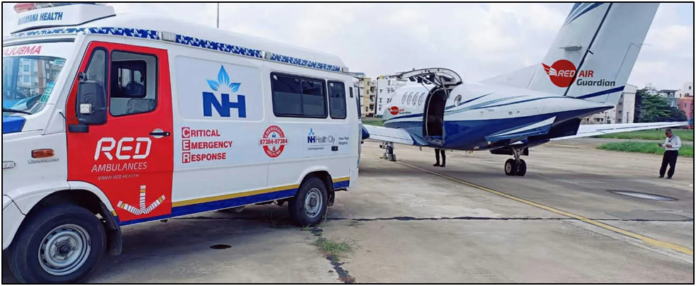Introduction:
Medical emergencies can come without warning, therefore the need for rapid and efficient transportation of critically ill or injured patients has never been more crucial. Well, this is where air ambulance services come into play, and are offering a vital lifeline that bridges the gap between distant locations and the medical care required.
But still there are so many people who have no idea what exactly an air ambulance is, and how does it work? Well, this article delves into the intricacies of air ambulances, exploring their function, importance, and the factors influencing air ambulance cost. Keep on reading till the end to know about the same in detail!
Understanding Air Ambulances:
An air ambulance is a specially equipped aircraft used to transport patients in need of urgent medical care. Unlike regular ambulances that operate on the ground, air ambulances are either fixed-wing airplanes or helicopters, capable of covering vast distances in a short time. These flying ambulances are staffed with highly trained medical personnel, including doctors, nurses, and paramedics, who are equipped to provide critical care during the flight.
Air ambulances are typically used in scenarios where ground transportation would be too slow or impractical, such as when a patient is located in a remote area or when time is of the essence in reaching a specialized medical facility. The swift transportation provided by air ambulances can be the difference between life and death, making them an indispensable part of modern healthcare systems.
How Does an Air Ambulance Work?
The operation of an air ambulance involves several key steps, each critical to ensuring the safe and effective transfer of patients.
1. Initial Contact and Assessment
The process begins when a request for an air ambulance is made. This can be initiated by hospitals, medical facilities, or even individuals in some cases. Once the request is received, a medical team evaluates the patient’s condition to determine if air transport is necessary and feasible. Factors such as the patient’s medical stability, the urgency of the situation, and the distance to be covered are considered during this assessment.
2. Coordination and Preparation
Once the decision to use an air ambulance is made, coordination efforts commence. The air ambulance provider arranges for the appropriate aircraft based on the patient’s needs and the distance to be traveled. Helicopters are typically used for shorter distances, while fixed-wing airplanes are preferred for long-haul flights.
The medical team prepares for the transfer by gathering all necessary equipment, medications, and supplies. This may include ventilators, defibrillators, intravenous fluids, and monitoring devices, ensuring the patient receives continuous care during the flight.
3. Patient Transfer and Loading
The patient is then carefully transferred from the hospital or accident scene to the air ambulance. This process involves the use of stretchers or specialized loading equipment to ensure the patient’s safety and comfort. The medical team continues to monitor and stabilize the patient throughout the transfer process.
4. In-Flight Care
Once airborne, the medical team remains vigilant, providing ongoing care and monitoring the patient’s vital signs. The aircraft is equipped with advanced life-support systems, allowing the team to administer treatments and respond to any changes in the patient’s condition. Communication with the receiving medical facility is maintained throughout the flight to ensure a smooth handover upon arrival.
5. Arrival and Handover
Upon reaching the destination, the patient is carefully unloaded and transferred to the awaiting medical team at the receiving facility. A detailed handover is conducted, during which the air ambulance team provides a comprehensive report on the patient’s condition and any treatments administered during the flight.
The Cost of Air Ambulance Services
One of the most significant considerations for those in need of air ambulance services is the air ambulance cost. The cost can vary widely depending on several factors, including the type of aircraft used, the distance traveled, and the level of medical care required during the flight.
1. Aircraft Type and Availability
The type of aircraft used is one of the primary determinants of air ambulance cost. Helicopters, which are typically used for shorter distances, may be less expensive than fixed-wing airplanes, which are better suited for long-distance travel. However, the availability of aircraft can also impact the cost, as some regions may have limited options, leading to higher prices.
2. Distance and Fuel Costs
The distance to be covered is another critical factor influencing the air ambulance cost. Longer distances require more fuel and time, contributing to higher expenses. Additionally, the cost of fuel can fluctuate, further affecting the overall cost of the service.
3. Medical Equipment and Personnel
The level of care required during the flight also plays a significant role in determining the cost. Air ambulances are equipped with state-of-the-art medical equipment, and the presence of highly trained medical personnel is essential for providing critical care. The complexity of the patient’s condition may necessitate additional equipment or specialized staff, increasing the overall cost.
4. Insurance and Payment Options
Many people rely on insurance to cover the cost of air ambulance services. However, insurance coverage can vary, with some policies covering the full cost while others may only cover a portion. It is crucial for individuals to understand their insurance coverage and explore payment options in advance to avoid unexpected financial burdens.
The Importance of Air Ambulance Services
Despite the potential high costs, air ambulance services are invaluable in situations where time and specialized medical care are critical. They provide a rapid response solution for emergencies, ensuring that patients receive the necessary care as quickly as possible. The ability to transport patients across long distances in a matter of hours can be the difference between a successful recovery and a life-threatening situation.
Moreover, air ambulances play a crucial role in disaster response, humanitarian missions, and organ transplant logistics, where timing is of the utmost importance. They enable medical teams to reach remote or inaccessible areas, providing life-saving care to those in need.
Conclusion
In conclusion, air ambulances are a vital component of modern healthcare, offering rapid and efficient transportation for critically ill or injured patients. While the air ambulance cost can be significant, the benefits provided by air ambulance services far outweigh the expenses, particularly in life-threatening situations. Understanding how these services work and the factors influencing their cost can help individuals make informed decisions during emergencies, ensuring they receive the care they need when it matters most and RED is always there to help. Contact the team to get air ambulances at cost-effective prices.


























